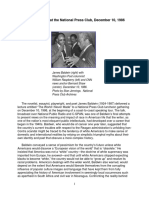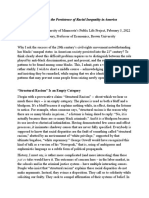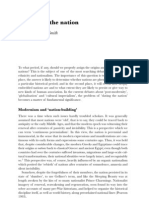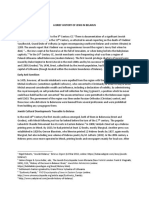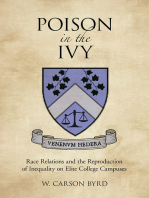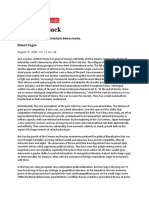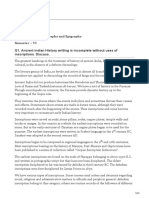Professional Documents
Culture Documents
Ancient India
Ancient India
Uploaded by
Christian Paul PeligroOriginal Description:
Copyright
Available Formats
Share this document
Did you find this document useful?
Is this content inappropriate?
Report this DocumentCopyright:
Available Formats
Ancient India
Ancient India
Uploaded by
Christian Paul PeligroCopyright:
Available Formats
The Settlement of Aryans It took the tall, beautiful, long limbed Aryans surprisingly little time to get used
to their new home. Initially, they settled in the area of Sapt-Sindhu, which included Punjab, Kashmir, Sindh, Kabul and Gandhara (Kandhar). The chief sources of this period which have come down to us are The Vedas and the Epics, the Mahabharata and the Ramayana, which through their stories and hymns tell us about the expansion of the Aryans. It took them about a thousand years to bring the entire northern region under their control. Then they turned their attention to the south. The epic Ramayana is a symbolic tale which tells of the Aryan expansion to the south the good, almost godly, aryaputra (an Aryan's son) king Rama surging forth to finish off the evil Dasyu (that was what the Aryans called the natives) Ravana. Aryans Political System The political system of the Aryans in their initial days here was amazingly complex, though quite ingenious. They hung around together in small village settlements (which later grew to kingdoms) and the basis of their political and social organization was, not surprisingly, the clan or kula. Being of somewhat militant nature, this was very much a patriarchal society, with the man
in the house expected to keep his flock in control. Groups of kulas together formed a Grama or village, which was headed by a Gramina. Many villages formed another political unit called a Visya, headed by a Visyapati. The Visyas in turn collected under a Jana, which was ruled by a Rajana or king. However, the precise relationship between the grama, the visya and the jana has not been clearly defined anywhere. The King Was The Supreme Power The king was yet to become that the all-powerful monarch that he eventually became. Although he lived as befitted a king, he was supposed to work in tandem with the people's wishes. He had an elaborate court of many officials, including the chief queen (Mahishi) who was expected to help in the decision making process. Two assemblies, Sabha and Samiti further assisted the king. The Samiti was roughly equivalent to our modern Lower House or the Lok Sabha, with members that represented the people, and the Sabha was a permanent body of selected men. So everything was very proper and democratic. This was obviously speedily amended. As one Jana swallowed another and kingdoms arose out of their ashes, the king became increasingly the despot that we are all more familiar with. Women seemed to have had it good at this time, but then through almost all of the ancient period of Indian history women continued to command respect and considerable pull in society. Although by the time of the Mahabharata their position had fallen enough for them to be treated as a man's property, as is evinced by the episode where Yudhistra gambles away his wife (see Mahabharata). Conquest of Alexander in India [327 BC] The throne of Macedon in south-east Europe has been occupied by Alexander. Having defeated the last of the Persian rulers and conquered the Acharmenian empire, Alexander has vowed to conquer the Indian satraps. His army has crossed the Hindukush mountains and is strengthening its position near Kabul. He has captured the fortresses of Massaga and Aornos. Alexander is from a far off land called Greece. This is reportedly beyond the horizon. The astonishing fact about this he is just 21 years old! It's known from well-placed sources that he is planning to launch a major attack on the Pauravan king across the Jhelum river. The Pauravan king is planning a massive counter attack. India, 326 BC: Alexander moves through the dense jungles of Ohind. Then, having crossed the Indus river and secured the help of the Ambhi, king of Taxila, Alexander marches on to the Jhelum. The Pauravan king with an army of 30,000 soldiers, horses and elephants provided fierce resistance but was eventually defeated.
When Alexander asked the Pauravan king to bow, the latter answered, "Act like a King". Impressed by the Pauravan king's efforts he has given him back his kingdom. Alexander has moved further. He concentrated on capturing the Chenab and Ravi plains upto Beas. This strategy of Alexander is typical of the great Greek rulers. Having conquered several tribes and satraps, Alexander has received many presents including brocades, gems, tigers, etc. He wanted to move further towards the Ganges valley, but has been stopped by his tired troops. So with a heavy heart, Alexander has retraced his steps to the Jhelum. He has been severally wounded while storming one of the citadels of the powerful tribe of Malavas. Through the desserts of Baluchistan and with terrible sufferings, he has reached Babylon. And in 323 BC , not very long after his return to Babylon, Alexander dies. "The hold of the great king [Alexander] on the Indian frontier slackened considerably in the fourth century BC. The arduous campaigns of Alexander restored the fallen fabric of imperialism and laid the foundation of a closer contact between India and the Hellenic world. The Macedonian empire in the Indus valley no doubt perished within a short time. But the Macedonian had welded the political atoms into one unit and thus paved the way for the permanent union under the Mauryas." The Mauryan Dynasty (The first Indian Empire) Chandragupta Maurya [322-298 BC] Chandragupta, with the help Chanakya (Kautilya), who is also known as the Indian Machiavelli, destroyed the Nanda rulers of Magadha and established the Mauryan empire. It is said that Chanakya met Chandragupta in the Vindhya forest, after being insulted by the Nanda king. Alexander's invasion prompted Indians to develop a centralised state. Chandragupta declared war and defeated Selucus Nicator, the Macedonian ruler of the Northwestern territories captured by Alexander the Great. Along with the the astute advice of Chanakya, Chandragupta also seized Punjab, Kabul, Khandahar, Gandhara and Persia from Seluces. Seluces' daughter was married to Chandragupta. Sequence Mauryan Empire - Bindusara [298 BC] After ruling for about twenty five years, Chandragupta left his throne to his son Bindusara and became a Jain ascetic. Bindusara inherited an empire including the Hindukush, Narmada, Vindhyas, Mysore, Bihar, Bengal, Orissa, Assam, Baluchistan & Afghanistan. He was called Amitraghata which means "slayer of foes" by Greek writers. Bindusara extended his empire further as far as south Mysore. He conquered sixteen states and extended the empire from sea to sea. The empire included the whole of India except the region of Kalinga (modern Orissa) and the Dravidian kingdoms of the south. The Dravidians kingdoms of the Cholas, Pandyas and Cheras were very friendly with the Mauryan empire and so the king felt no need to conquer them. However, Kalinga was not friendly with the Mauryans and so a war was fought between the people of Kalinga and Mauryans led by Bindusara's son Ashoka. Administration during Bindusara's Reign Bindusara maintained good relations with Selucus Nicator and the emperors regularly exchanged ambassadors and presents. He also maintained the friendly relations with the Hellenic West established by his father. Ambassadors from Syria and Egypt lived at Bindusara's court. He preferred the Ajivika philosophy rather than Jainism. Mauryan Empire - Ashoka [273 BC] Ashoka, the most trusted son of Bindusara and the grandson of Chandragupta Maurya, was a brave soldier. He was the most famous of the Mauryan kings and was one of the greatest rulers of India. During his father's reign, he was the governor of Ujjain and Taxila. Having sidelined all claims to the throne from his brothers, Ashoka was coronated as an emperor. Ashoka extended the Maurya Empire to the whole of India except the deep south and the south-east, reaching out even into Central Asia.
The Kalinga War [261 BC] Ashoka succeeded in conquering Kalinga after a bloody war in which 100,000 men were killed, 150,000 injured and thousands were captured and retained as slaves. The sight of the slaughter involved in his conquest deeply distressed Ashoka and deeply affected his mind. This was a turning point in his life. He renounced war and sought peace in Buddha's preachings of love and ahimsa (non-violence). The war also developed in him a hatred for all kinds of violence. So he gave up hunting and slaughtering of animals. He became a strict vegetarian. Under his reign Buddhism spread to Syria, Egypt, Macedonia, Central Asia, Burma. For propagation of Buddhism, he started inscribing edicts on rocks and pillars at places where people could easily read them. These pillars and rocks are still found in India, spreading their message of love and peace for the last two thousand years. To his ideas he gave the nameDharma. Ashoka died in 232 BC. The capital of Ashoka pillar at Sarnath is adopted by India as its national emblem. The "Dharma Chakra" on the Ashoka Pillar adorns our National Flag. Fall of Mauryas Emperor Ashoka ruled for 37 years. He died in 232 BC. During his reign he gave up war and preached peace in the kingdom. Seven kings (some say 10) followed Ashoka within a period of 50 years. The Mauryan empire was breaking up. There are different opinions about the fall of the kingdom. Some say that since the later part of Ashoka's reign was devoid of wars, the military were inactive and this weakened them. Others say after Ashoka there were no strong kings to rule such a vast empire. Sungas Dynasty The last ruler of the Mauryan dynasty was Brithadratha. He was killed by his own commander-in-chief Pushyamitra Sunga in 185 BC. With the fall of Mauryas, India lost its political unity. Pushyamitra Sunga became the ruler of the Magadha and neighbouring territories. The north-western regions comprising Rajputana, Malwa and Punjab passed into the hands of the foreign rulers. The kingdom of Pushyamitra was extended upto Narmada in the south, and controlled Jalandhar and Sialkot in the Punjab in the north-western regions. Pushyamitra died after ruling for 36 years (187-151 BC). He was succeeded by son Agnimitra. This prince is the hero of a famous drama by India's greatest playwright, Kalidasa. Agnimitra used to hold his court in the city of Vidisa, modern Besnagar in Eastern Malwa. The power of the Sungas gradually weakened. It is said that there were ten Sunga kings. Kanva Dynasty (75BC - 30BC) The last ruler of the Sunga dynasty was overthrown by Vasudeva of the Kanva dynasty in 75 BC. The Kanva ruler allowed the kings of the Sunga dynasty to continue to rule in obscurity in a corner of their former dominions. Magadha was ruled by four Kanva rulers. In 30 BC, the southern power swept away both the Kanvas and Sungas and the province of Eastern Malwa was absorbed within the dominions of the conqueror. The Satvahana Dynasty After the decline of the Mauryan empire the Satvahanas established their kingdom in the Deccan. They were also known as Andhras. They first rose to power in present Maharashtra on the banks of the Godavari. The founder of the Satvahanas was Simuka. But the man who raised it to eminence was Satakarni I. The Satvahana dynasty began its rule in about 40 or 30 BC, and continued until the 3rd century AD. Satakarni I allied with powerful Marathi chieftain and signalled his accession to power by performing ashvamedhas (horse-sacrifice). After his death, the Satvahana power seemed to have been submerged beneath a wave of Scythian invasion. Reign of Gautamiputra (AD 80-104) Gautamiputra Satakarni was the famous king during the Satvahana dynasty. He defeated the Sakas (Scythians), Yavanas (Greeks) and Pahlavas (Parithans). His empire extended upto Banavasi in the south, and included
Maharashtra, Konkan, Saurashtra, Malwa, west Rajasthan and Vidharbha. His son, Vasishtiputra, ruled at Paithan on the banks of Godavari. Two other cities, Vaijayanti (in North Kanara) and Amravati (in the Guntur district), attained eminence during the Satvahana period. Kings succeeding Gautamiputra lost many of their territories. But the power of Satvahanas revived under Sri Yajna Satakarni, who was the last great king. After him, the empire began to decline. Some scholars say the there were 19 kings of this dynasty which ruled for 300 years, while others say there were 30 kings who ruled for 456 years. The dynasty came to an end about the middle of the third century AD. (after AD 220). Their empire broke up into small states ruled by the Abhiras, Chutus, Ikshvakus, Pallavas. Establishment of Kushans (AD 50) The Kushans were a branch of the nomadic Yeuhchi tribe of China. The Yeuhchi tribe was in conflict with another tribe and so was forced to leave China. They came to Central Asia and then spread to Bactria, Paritha and Afghanistan. Gradually they were divided into five branches. One of these branches -- Kouel Chougang (Kushans) - was superior to all. The Kushans under Kujala attacked the Parithans, took possessions of Ki-pin and Kabul and became the complete master of the Indian borderland. Kujala became the first king of the Kushans and was known as Kadphises I. He was a great warrior. He was succeeded by his son Wima Kadphises known as Kadphises II. He conquered the north-western region of India. He defeated Saka Satraps in the north-west. Punjab and Sind were his dominions. Reign of Kanishka (AD 120) Kanishka was the most famous of the Kushan kings. It is not known how he became the king but he ascended the throne in AD 120. When Kanishka ascended the throne, his empire consisted of Afghanistan, Sind, Punjab and portions of the former Parithan and Bactrian kingdoms. His empire extended from the north-west and Kashmir, over most of the Gangetic valley. He annexed three provinces of the Chinese empire, namely, Tashkand, Khotan and Yarkhand. He was the only king who ruled over these territories. He had two capitals at Purushpura (Peshawar now in Pakistan) and at Mathura in west Uttar Pradesh. Kanishka proved that he was a great conqueror. Successors of Kanishka Kanishka's immediate successor was Vashiska who was then succeeded by Huvishka. Mathura became the centre of Kushans. Many monuments were erected during Huvishka's reign. The last great king of Kushans was Vasudev I. The Kushans were overthrown by the Sassanians of Persia in the north-west and the Guptas in the north. The rule of Kushans ended almost at the same time as that of the Satavahans in the south. Buddhism during the Kushans Kanishka embraced Buddhism towards the middle of his reign. He is said to have been Zoroastrian before he became Buddhist. He spent his resources in spreading Buddhism. Mahayana was the new form of Buddhism that was followed during this period where the Buddha was worshipped as God. Old monastries were repaired and many new ones were built. Art, Science and Literature Kanishka was a great patron of art and literature. A new form of art Gandhara Art was developed. Beautiful images of Buddha were developed in a Greek-Roman style. These images were carved in a realistic way, with graceful bodies and curly hair. Kanishka's court was adorned by many scholars like Ashvaghosha, Vasumitra, Nagarjuna and Charaka. Ashvaghosha was a great poet and a master of music. He wrote Buddhacharita, a biography of the Buddha. Charak was a great physician and he wrote a book Charak Samhita, which is based on the Ayurvedic system of medicine. Gupta Dynasty
After the Kushans, the Guptas were the most important dynasty. The information about Guptas is known from the archaeological remains, inscriptions and coins. Early in the beginning of the fourth century, a chief called Sri Gupta ruled a small kingdom in Magadha. He was then succeeded by his son Ghatokacha. They were mostly minor rulers in east Uttar Pradesh and Bihar. Reign of Chandragupta I (AD 320-335) The first famous king of the Gupta dynasty was Ghatokacha's son Chandragupta I. He married Kumaradevi, the daughter of the chief of the Lichhavis. This marriage was a turning point to Chandragupta I. He got Patliputra in dowry from the Lichhavis. From Patliputra, he laid the foundation of his empire and started conquering many neighbouring states with the help of the Lichhavis. He ruled over Magadha (Bihar), Prayaga and Saketa (east Uttar Pradesh). His kingdom extended from the river Ganges to Allahabad. Chandragupta I also got the title of Maharajadhiraja (King of Kings) and ruled for about fifteen years. An important act of Chandragupta I was the holding of an assembly of councillors and members of the royal family at which Prince Samudragupta was formally nominated as the successor of the Gupta empire. Harishena's Inscription Samudragupta was the son of Chandragupta I and though the exact date of his birth is not known, it seems he must have ascended the throne after the death of his father Chandragupta I in AD 335. The information about his reign is on an inscription engraved on a pillar at Allahabad. The text of this inscription was recorded by Harishena, the court poet of Samudragupta. Part of the inscription was lost in the course of time. Harishena's inscription tells us about Samudragupta's various conquests and small kingdoms existing at that time. Samudragupta also left an extensive coinage which supports the information of the inscription. Samudragupta's Conquest Samudragupta was a great warrior. His passion of conquest was so great that he did not rest till he captured almost whole of India. It seems Samudragupta first waged wars against the neighbouring kingdoms of Shichchhatra (Rohilkhand) and Padmavati (in Central India), then ruled by Achyuta and Nagasena. Then he incorporated in the Gupta empire the kingdom of Kota kings by defeating him. He also waged wars against tribal states like those of Malvas, the Yaudheyas, the Arjunayanas, the Maduras and the Abhiras. The descendants of Kushanas, many chieftains of Sakas, the Ceylonese hastened to propitiate the great Gupta by offering homage and tribute or presents. Samudragupta's daring adventure was his military expedition to the south along the coast of the Bay of Bengal. He defeated Mahendra of Khosla, Mantaraja of Kurala, Mahendragiri of Pithapuram, Svamidatta of Kottura, Damana of Erandapalla, Vishnugupta - the Pallava king of Kanchi, Kubera of Devarashtrain the Vizagapatam district and Dhananjaya of Kushthalapur possible in North Arcot. Samudragupta did not go beyond the river Krishna. Towards the west, Samudragupta subdued Palaghat, Maharashtra and Khandesh. He did not annex any part of the Deccan to his empire as he knew that it would be difficult to control those territories situated so far from Patliputra. Samudragupta's territories extended from the Himalayas in the north to the river Narbada in the south and from the Brahamaputra river in the east to the Yamuna river in the west. Then there were other kingdoms like Assam, Nepal, Devaka, Kartipura. Samudragupta's Reign Samudragupta is considered as one of the greatest rulers in Indian history. He is also compared to Alexander or Napoleon as a conqueror. He performed Ashwamedha Yajna (horse sacrifice) after defeating nine kings in the north and twelve kings in the south to underline the importance of his conquest of almost the whole of India. He also assumed the title ofMaharajadhiraja (King of Kings) and Chakravartin (Universal Monarch). Samudragupta was not a only a great warrior but also a great patron of art and literature. He gathered around himself a galaxy of poets and scholars, the most prominent ones being Harishena, Vasubandhu and Asanga. He himself was a great poet and musician. In one of his coins, he is shown playing the Veena. Samudragupta was a staunch believer of Hinduism and was a worshiper of Lord Vishnu. He also respected other religions like Buddhism and also allowed the Buddhist king of Ceylon to build a monastery at Bodh-Gaya.
Empire of Chandragupta II [AD 380-413] Chandragupta succeeded his father Samudragupta. He got the title of Vikramaditya (son of power), so he is also known as Chandragupta Vikramaditya. Chandragupta II proved to be of the same military mettle of his father and brought large amounts of territory in Western India under the Gupta empire. From the inscription of the Mehrauli Iron Pillar of Chandragupta II situated in Delhi, it is learnt that he waged successful wars against several chiefs of Vanga (Bengal). However Chandragupta II's greatest achievement was the victory over the Saka Satraps of Malwa, Gujarat and Saurashtra. Chandragupta's Biggest Achievement Chandragupta marched against the Saka Satraps about AD 389. After six years of courageous fighting, he killed the Sakas chieftains. He killed Rudrasena III, a Saka king of West India. He annexed all the three kingdoms of Satraps under Gupta empire and made Ujjain a second capital, and called himself Vikramaditya -- a combination of words valour and sun. Chandragupta's empire had both the Arabian Sea coast and that of the Bay of Bengal under its control. He also captured Bactria and concluded marital alliances with the Nagas, Vakatakas and Kadamba dynasties. Like his grandfather, Chandragupta married the Lichhavi princess Kumaradevi. He gave his daughter Prabhavati in marriage to Rudrasena II, the Venkata king of Central India. Rudrasena had helped him in his campaign against the Saka Satraps. Administrations and Coins The account of administration of Chandragupta's reign is known from the Chinese pilgrim Fa Hein who came to India during that period. The administration was very well organised with very light taxes. The empire was divided into many provinces which were ruled by independent governors. The provinces were further divided into districts. Land revenue was the main source of income of the state and was normally one-sixth of the produce of the land. The emperor also issued a host of gold, silver and copper coins to celebrate his reign. His coins featured Vishnu and his garuda, as well as images of himself killing a lion, among others. Experts say that Chandragupta II's coin are of a finer quality than had been seen thus far. Chandragupta II was succeeded by his son Kumargupta who was also a great ruler. Reign of Kumaragupta [AD 415-455] Chandragupta II (Vikramaditya) was succeeded by his son Kumaragupta. Like his father, Kumaragupta was also a very great and able ruler. He was able to keep the vast empire, which extended from North Bengal to Kathiawar and from the Himalayas to the Nerbudda, intact. He ruled efficiently for nearly forty years. However, the last days of his reign were not good. The Gupta empire was threatened by the invasions of Pushyamitras. The Pushyamitras were a tribe of foreigners who were settled in Central India. However, Kumaragupta was successful in defeating the invaders and performedAshvamedha Yajna (horse sacrifice) to celebrate his victory. He issued new coins with images of Lord Kartikeya. Skandagupta becomes the King Kumaragupta died in AD 455 and was succeeded by his son Skandagupta. During his reign, the invasions of the Huns became more frequent. Skandagupta repelled their early invasions and recovered most of the imperial provinces. But the continuous attack of the Huns weakened the Gupta empire. Skandagupta died in AD 467. After his death, the Gupta empire began to decline. Decline of the Gupta Empire Inscriptions prove that the Gupta sovereignty was acknowledged in the Jabbalpur region in the Nebudda valley as late as AD 528, and in North Bengal till AD 543-544. Kumaragupta is known to have been ruling in AD 473-474,
Buddhagupta from AD 476-495, Vainyagupta in AD 508 and Bhanugupta in AD 510-511. The Gupta empire became to disintegrate and till the middle of the sixth century AD, they had merely became petty chiefs. Harsha Vardhana -- The Ruler of Vardhana Dynasty The final important ruler of Ancient Indian history was Harsha Vardhana (606-646AD), who ruled not from Magadha butThanesar (in modern Haryana area) of the Vardhana dynasty. He was a Buddhist and convened many Buddhist assemblies. The second Chinese traveller to come to India, Huien Tsang, arrived during his reign. By all accounts Harsha was all the usual things that one associates with a good king. However, lots of petty dynasties like the Maukharis and the Vakatakas had started springing up all over the place, and the confusion which is generally associated with the absence of a strong central dynasty was rife. The south presented a medley of dynasties around the time of Harsha Vardhana. There were the Pandyas (in regions of Mudurai, Travancore and Tinnevelly), the Chalukyas (in present Maharashtra region) and Pallavas (in modern Tamil Nadu region), who had this terrific battle of supremacy going constantly. Pulakesan II (610-642AD) was the ablest of the Chalukyan kings and for a time managed to keep the Chalukyan flag flying above the others. But strictly for a time being. The Chalukyas gained Importance The Chalukyas rose to power in the Deccan from the fifth to eighth century and again from the tenth to twelfth century. They ruled over the area between the Vindhyan mountain and the river Krishna. The Chalukyas were sworn enemies of the Pallavas and rose to power in Karnataka. The first great ruler of the Chalukya dynasty was Pulakesin I. He founded Vatapi (modern Badami in Bijapur district) and made it his capital. He is said to have performed Ashwamedha Yagna (horse sacrifice). The kingdom was further extended by his sons Kirtivarman and Mangalesa by waging many successful wars against the neighbours including Mauryans of the Konkans. Reign of Pulakesin II Pulakesin II was the son of Kirtivarman. He was the the greatest ruler of the Chalukya dynasty. He ruled for almost 34 years. In this long reign, he consolidated his authority in Maharashtra and conquered large parts of the Deccan from the banks of the Nerbudda to the reign beyond the Kaveri. His greatest achievement was his victory in the defensive war against Harshvardhan in 620. In 641, the Chinese pilgrim Hiuen Tsang, visited the kingdom and said that the king was served by his nobles with perfect loyalty. However the last days of the king were not happy. Pulakesin was defeated and killed by the Pallav king Narasimhavarman in 642. His capital Vatapi was completely destroyed. End of Chalukya Dynasty Pulakestin was succeeded by his son Vikramaditya who was also as great a ruler as his father. He renewed the struggle against his southern enemies. He recovered the former glory of the Chalukyas to a great extent. Even his great grandson Vikramaditya II was also a great warrior. He actually entered the Pallava capital. In 753, Vikramaditya and his son were overthrown by a chief named Dantidurga who laid the foundation of the next great empire of Karnataka and Maharashtra, that of Rashtrakutas.
A Brief Introduction to Jainism
Along with Buddhism, Jainism is the most important reform movement to separate from the main body of Hinduism and establish an independent unit. The word is derived from Jina ("Victor," or "Conqueror") implying final victory over bondage to life's misery. Jainism has the universal message of nonviolence. The absence of a creator god in Jainism can be understood as a reaction against the nature worship of early Vedic religion, the priestly order of Brahmanism, and the theology of the Upanishads. Jain arts and architecture has enriched the artistic heritage of India. Jainism was founded by Rishabha, and attained a major status in India at the time of Mahavira , who was born in about 599 B.C. in Northern India, in the town of Vyshali, in the present day Bihar, in a royal family. When he was about 30 years old, after he had been a householder, Mahavira decided to abandon his aristocratic surroundings in favor of an ascetic life. He cast aside his fine raiment, gave away his treasures, and embarked upon a severe regimen. For twelve years he underwent castigation, enduring bodily and spiritual injury, and emerged a teacher of many monks, a renowned preacher, and a profounder of a new religion.
Chief among the tenets of Jainism is the deification of Mahavira. The Agamas ("Precepts") and Siddhantas ("Treatises"), declare him to be incarnate and preeminent, a venerable savior of men, the last of twenty-four tirthankaras (perfect souls). Jainism also preaches thatkarma is knowable and ineffable and that it is a cosmic power which directs retribution in the hereafter; this represents a marked break with the speculative Brahma of Hinduism.
You might also like
- Invisible Hands The Businessmen's Crusade Against The New Deal by Kim Phillips-FeinDocument349 pagesInvisible Hands The Businessmen's Crusade Against The New Deal by Kim Phillips-Feinfr33bookspleaseNo ratings yet
- The Backstreets Xinjiang - Perhat TursunDocument166 pagesThe Backstreets Xinjiang - Perhat TursunsalimamaticNo ratings yet
- Joseph Jackson, "Annual Address To The National Baptist Convention," 1964Document2 pagesJoseph Jackson, "Annual Address To The National Baptist Convention," 1964Kathleen NilesNo ratings yet
- Tabachnick-Of Maus and Memory 1993Document10 pagesTabachnick-Of Maus and Memory 1993A Guzmán MazaNo ratings yet
- The clamour of nationalism: Race and nation in twenty-first-century BritainFrom EverandThe clamour of nationalism: Race and nation in twenty-first-century BritainNo ratings yet
- Ethnicity - Vol.1 - Understanding ConceptsDocument145 pagesEthnicity - Vol.1 - Understanding Conceptssaurabh pantNo ratings yet
- EU CitizenshipDocument7 pagesEU CitizenshipKen Adams100% (2)
- Hill Tribe in LaosDocument100 pagesHill Tribe in Laosreza32393No ratings yet
- Case StudiesDocument31 pagesCase StudiesChristian Paul PeligroNo ratings yet
- National Identity - Annotated BibliographyDocument37 pagesNational Identity - Annotated BibliographyzapelNo ratings yet
- Peacebuilding in Practice: Local Experience in Two Bosnian TownsFrom EverandPeacebuilding in Practice: Local Experience in Two Bosnian TownsNo ratings yet
- Kalla Broockman Donor Access Field ExperimentDocument24 pagesKalla Broockman Donor Access Field ExperimentArthur M. ColléNo ratings yet
- Lemko CultureDocument6 pagesLemko CultureFibichovaNo ratings yet
- Leaders of the Lost CauseFrom EverandLeaders of the Lost CauseGary W. GallagherRating: 4 out of 5 stars4/5 (7)
- Between Dictatorship Demoracy: Post-Communist Political ReformDocument377 pagesBetween Dictatorship Demoracy: Post-Communist Political ReformCarnegie Endowment for International Peace100% (2)
- Garner - Racisms - CH 1Document18 pagesGarner - Racisms - CH 1Dazza1960No ratings yet
- Champions of Civil and Human Rights in South Carolina, Volume 1: Dawn of the Movement Era, 1955–1967From EverandChampions of Civil and Human Rights in South Carolina, Volume 1: Dawn of the Movement Era, 1955–1967Marvin Ira LareNo ratings yet
- Why Comunism Didn't CollapseDocument31 pagesWhy Comunism Didn't Collapseapi-3732963No ratings yet
- A Case For IdentityDocument3 pagesA Case For IdentityAndhyta Firselly UtamiNo ratings yet
- James BaldwinDocument14 pagesJames BaldwinUfuoma AsagbaNo ratings yet
- Syllabus (Non-Governmental Organizations)Document6 pagesSyllabus (Non-Governmental Organizations)Anass Ainouni100% (1)
- Sharkey J. 2007 Arab Identity and Ideology in Sudan The Politics of Language Ethnicity and Race2 AnnotatedDocument23 pagesSharkey J. 2007 Arab Identity and Ideology in Sudan The Politics of Language Ethnicity and Race2 AnnotatedAmmar Mustafa Mahadi AlzeinNo ratings yet
- (Andre N PDFDocument399 pages(Andre N PDFHuddyNo ratings yet
- A Hard Country and a Lonely Place: Schooling, Society, and Reform in Rural Virginia, 1870-1920From EverandA Hard Country and a Lonely Place: Schooling, Society, and Reform in Rural Virginia, 1870-1920No ratings yet
- Slavery and JusticeDocument107 pagesSlavery and JusticevbonduraNo ratings yet
- Public Opinion and Democratic Accountability: How Citizens Learn about PoliticsFrom EverandPublic Opinion and Democratic Accountability: How Citizens Learn about PoliticsNo ratings yet
- A Cultural History of Underdevelopment: Latin America in the U.S. ImaginationFrom EverandA Cultural History of Underdevelopment: Latin America in the U.S. ImaginationNo ratings yet
- Dilemmas of Modernity: Bolivian Encounters with Law and LiberalismFrom EverandDilemmas of Modernity: Bolivian Encounters with Law and LiberalismNo ratings yet
- A Lecture For The University of Minnesota's Public Life Project, February 3, 2022Document12 pagesA Lecture For The University of Minnesota's Public Life Project, February 3, 2022The College FixNo ratings yet
- The Origins of Contemporary Romanian PopulismDocument22 pagesThe Origins of Contemporary Romanian PopulismAndrei TaranuNo ratings yet
- Inventing America's Worst Family: Eugenics, Islam, and the Fall and Rise of the Tribe of IshmaelFrom EverandInventing America's Worst Family: Eugenics, Islam, and the Fall and Rise of the Tribe of IshmaelRating: 5 out of 5 stars5/5 (2)
- Iran Contra EssayDocument7 pagesIran Contra EssayDonovanNo ratings yet
- The Spymaster of Baghdad: A True Story of Bravery, Family, and Patriotism in the Battle against ISISFrom EverandThe Spymaster of Baghdad: A True Story of Bravery, Family, and Patriotism in the Battle against ISISNo ratings yet
- Subcultures, Pop Music and PoliticsDocument23 pagesSubcultures, Pop Music and PoliticsRoxana Ene100% (1)
- Hakibbutz Ha’artzi, Mapam, and the Demise of the Israeli Labor MovementFrom EverandHakibbutz Ha’artzi, Mapam, and the Demise of the Israeli Labor MovementNo ratings yet
- Lebanon Is Sick and Tired of Syrian Refugees - Foreign PolicyDocument6 pagesLebanon Is Sick and Tired of Syrian Refugees - Foreign PolicyNinda Dananingrum100% (1)
- Empire of Nations: Ethnographic Knowledge and the Making of the Soviet UnionFrom EverandEmpire of Nations: Ethnographic Knowledge and the Making of the Soviet UnionRating: 2.5 out of 5 stars2.5/5 (2)
- Antislavery Debates: Tides of Historiography in Slavery and AntislaveryDocument18 pagesAntislavery Debates: Tides of Historiography in Slavery and AntislaveryNelly Stephanie Ramos GuivarNo ratings yet
- Texas Baptist Leaders and The Rise of The Christian Right 1960-1985Document257 pagesTexas Baptist Leaders and The Rise of The Christian Right 1960-1985Ŧee Barton100% (1)
- Discovering The Palestinian Refugee Paradox in Lebanon: Carol StephanDocument11 pagesDiscovering The Palestinian Refugee Paradox in Lebanon: Carol StephanMami Bebe100% (1)
- 7 Michael Mann The Source of Social PowerDocument5 pages7 Michael Mann The Source of Social PowergggNo ratings yet
- Homosexual Desire in Revolutionary Russia: The Regulation of Sexual and Gender DissentFrom EverandHomosexual Desire in Revolutionary Russia: The Regulation of Sexual and Gender DissentNo ratings yet
- De-Hinduising The Indian NationDocument20 pagesDe-Hinduising The Indian Nationkingponting100% (1)
- The Aesthetic Cold War: Decolonization and Global LiteratureFrom EverandThe Aesthetic Cold War: Decolonization and Global LiteratureNo ratings yet
- Russian Influence in MoldovaDocument26 pagesRussian Influence in Moldovacucuruza3312No ratings yet
- Rethinking Russias Post-Soviet DiasporaDocument21 pagesRethinking Russias Post-Soviet DiasporalacosNo ratings yet
- 3 Dating The Nation: Anthony D. SmithDocument19 pages3 Dating The Nation: Anthony D. SmithAlec PgnNo ratings yet
- Timeline BosniaDocument69 pagesTimeline BosniaEdo KrajinicNo ratings yet
- History of Jews in BelarusDocument3 pagesHistory of Jews in BelarusBrian Tice100% (1)
- Poison in the Ivy: Race Relations and the Reproduction of Inequality on Elite College CampusesFrom EverandPoison in the Ivy: Race Relations and the Reproduction of Inequality on Elite College CampusesNo ratings yet
- KAGAN Robert History's BackDocument5 pagesKAGAN Robert History's BackSimona StrimNo ratings yet
- Nation Into State: The Shifting Symbolic Foundations of American NationalismFrom EverandNation Into State: The Shifting Symbolic Foundations of American NationalismNo ratings yet
- Comparative Essay On Origins of Race-Based Slavery in United StatesDocument3 pagesComparative Essay On Origins of Race-Based Slavery in United StatesBrian A. SalmonsNo ratings yet
- The Reforms of Tsar Alexander II - Vladimir MossDocument33 pagesThe Reforms of Tsar Alexander II - Vladimir MossVäterchenNo ratings yet
- The Chattanooga Lookouts & 100 Seasons of Scenic City BaseballFrom EverandThe Chattanooga Lookouts & 100 Seasons of Scenic City BaseballNo ratings yet
- Affidavit of Loss: IN WITNESS WHEREOF, I Have Hereunto Affixed My Signature On This - Day ofDocument1 pageAffidavit of Loss: IN WITNESS WHEREOF, I Have Hereunto Affixed My Signature On This - Day ofChristian Paul PeligroNo ratings yet
- Educational LeadershipDocument44 pagesEducational LeadershipChristian Paul Peligro100% (3)
- 13th Month Pay LawDocument11 pages13th Month Pay LawChristian Paul PeligroNo ratings yet
- Code of KalantiawDocument5 pagesCode of KalantiawChristian Paul Peligro100% (1)
- 7 Trabajos de Vasubandhu - Seven Works of VasubandhuDocument504 pages7 Trabajos de Vasubandhu - Seven Works of VasubandhuRoberto Certain RuizNo ratings yet
- SamudraguptaDocument6 pagesSamudraguptaHitesh Gurnasinghani0% (1)
- TNPSC Group I & II NotesDocument42 pagesTNPSC Group I & II NoteseuginNo ratings yet
- 7 Rise and Growth ofDocument11 pages7 Rise and Growth ofShiv Shankar ShuklaNo ratings yet
- VanillaprotoplastDocument7 pagesVanillaprotoplastProject tcNo ratings yet
- Gupta EmpireDocument15 pagesGupta EmpireSaket SharmaNo ratings yet
- BrochureDocument7 pagesBrochureRajesh ShirkeNo ratings yet
- BPSC 2020 Most Probable QuestionsDocument456 pagesBPSC 2020 Most Probable QuestionsTej Pratap SinghNo ratings yet
- GuptaDocument35 pagesGuptaprabh jotNo ratings yet
- 3 - Gupta and Harsha PeriodDocument12 pages3 - Gupta and Harsha Periodkaushik joshiNo ratings yet
- The Gupta EmpireDocument17 pagesThe Gupta EmpireSyamNo ratings yet
- Gupta EmpireDocument48 pagesGupta EmpireSAN DNo ratings yet
- Gupta Empire - WikipediaDocument13 pagesGupta Empire - WikipediaBhattu.RajkiranNo ratings yet
- Art and Culture: VaridhiDocument26 pagesArt and Culture: VaridhiRam Prasad ChoudharyNo ratings yet
- The Rise and Growth of The Gupta Empire: BackgroundDocument4 pagesThe Rise and Growth of The Gupta Empire: BackgroundMonikaNo ratings yet
- 54 (A) Post Mauryan Period (200. BC-300 AD)Document20 pages54 (A) Post Mauryan Period (200. BC-300 AD)IAS EXAM PORTAL100% (2)
- Course: Ancient Cultures and Civilization of India Code: 5672 Semester: Autumn, 2020 Assignment No. 2Document27 pagesCourse: Ancient Cultures and Civilization of India Code: 5672 Semester: Autumn, 2020 Assignment No. 2Nargis RasheedNo ratings yet
- Vikramaditya and Kalkacharya Suri-LibreDocument31 pagesVikramaditya and Kalkacharya Suri-LibrePradeepPariharNo ratings yet
- Gupta and Post-Gupta SourcesDocument2 pagesGupta and Post-Gupta SourcesRamita Udayashankar100% (1)
- Test I. Identification - 1. Comes From The Latin Term "Abundare" Meaning To Overflow NonstopDocument2 pagesTest I. Identification - 1. Comes From The Latin Term "Abundare" Meaning To Overflow NonstopAnonymous PRyQ3MONo ratings yet
- Careerwill: Ancient HistoryDocument30 pagesCareerwill: Ancient HistoryGouthamshastri Gadicharla67% (3)
- Saidai TNPSC NotesDocument42 pagesSaidai TNPSC Notesshardha100% (4)
- Full Test-1 Sol 70th BPSC PT (E)Document12 pagesFull Test-1 Sol 70th BPSC PT (E)kaushikgaurav190No ratings yet
- A Presentation On PanchamahakavyasDocument22 pagesA Presentation On PanchamahakavyasMamtaGarg100% (3)
- Gupta PeriodDocument13 pagesGupta PeriodMs. Renuka CTGNo ratings yet
- The Gupta EmpireDocument4 pagesThe Gupta Empirebansalekansh50% (2)
- 322 PDFDocument26 pages322 PDFDeepankar SamajdarNo ratings yet
- Social Science: VI StandardDocument36 pagesSocial Science: VI Standardx a m xNo ratings yet
- Varna, Jatis and RemarriageDocument5 pagesVarna, Jatis and RemarriagesmrithiNo ratings yet
- Court Poets of Ancient IndiaDocument1 pageCourt Poets of Ancient Indiakchsayan16No ratings yet























